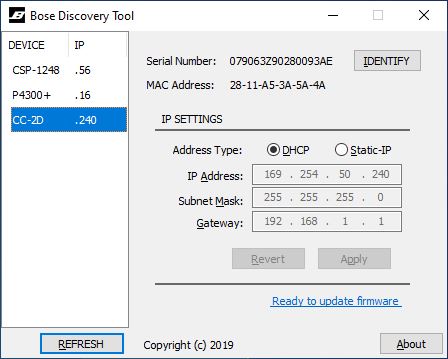The Discovery Tool is a dedicated application for Windows PCs. The application is used for network discovery of ControlCenter CC-xD controllers, PowerSpace+ amplifiers, and CSP processors. Discovery Tool is required for the network configuration of CC-xD controllers when they are used with PowerSpace+ and CSP processors.
The application can be downloaded from any CC-xD product page on www.boseprofessional.com. We recommend that you always download and use the latest version of the application.
Relevant Product(s)
- Discovery Tool
- ControlCenter CC-1D
- ControlCenter CC-2D
- ControlCenter CC-3D
Table of Contents
PowerSpace+/CSP device detection screen
ControlCenter CC-xD detection screen
Changing a controller's IP address
Updating a controller's firmware
Recovering a controller using Recovery mode
How to check the default gateway
Launching the app
Launch the app from the desktop icon or from the Start menu (the default location is Bose > Discovery Tool)
The icon on your Desktop may be different. To change it, you can right-click on the icon and select Properties > Change Icon.
Main screen
The tool auto-detects devices in the current network when it loads. On the left side of the screen, it will display the discovered devices with the last octet of each address.
REFRESH: Re-scan for devices
Devices may need about 40 seconds to a few minutes to fully boot after powering up. If a device is not automatically detected, use the REFRESH button to re-scan.
About: Discovery Tool version information, etc.
Menu icon (Bose logo): Windows menu and Recovery mode
PowerSpace+ / CSP device detection screen
When you select the PowerSpace+ and CSP devices that are displayed in the device list, you will see the IP address and the CONFIGURE button.
CONFIGURE: Opens the web browser user interface of the selected PowerSpace+ or CSP device in the PC's default browser.
A message will be displayed if the PowerSpace+ or CSP processor is outside of the PC's network range. The PC's IP address will need to be changed to match the device's network in order to access the browser-based configuration. See "Changing the Computer's IP Address in Windows."
ControlCenter CC-xD detection screen
When you select a CC-xD controller from the device list, you can see its serial number, MAC address, and current network configuration.
IDENTIFY: The LEDs on the controller will flash 5 times. If you have multiple controllers connected, this will help you identify which controller's settings you are adjusting.
IP SETTINGS

Address Type: DHCP (automatic) or Static-IP (static/fixed)
IP Address:
Static-IP: 192.168.***.***
At link local address: 169.254.***.***
Subnet Mask:
Static-IP configuration: 255.255.255.0
At link local address: 255.255.0.0.
Gateway: Gateway address of routers and DHCP servers
Revert: Restores previous settings
Apply: Saves the new configuration
Changing a controller's IP address
If the Address Type is DHCP (the default), the IP address is automatically assigned, and the IP address input fields cannot be changed.
When Static-IP is selected, you can manually input each IP address setting. After you enter your changes, click Apply to run them.
(If you want to check the default gateway of the current network, please see below for how to check the default gateway)
Available static IP addresses: [192.168.***.*** (/24)]
Example:
IP Address 192.168.0.201
Subnet Mask 255.255.255.0
Gateway 192.168.0.1
After clicking Apply for new IP settings, you will see a progress bar.
Updating a controller's firmware
Applies to: ControlCenter CC-1D, CC-2D, and CC-3D
If you want to use the CC-xD controller with CSP, you must use the Discovery Tool to update controller's firmware to the latest version.
(If your controller is not up-to-date, it may not work properly. The latest firmware for CC-xD is included inside the latest version of the Discovery Tool application.)
If new firmware is available, Ready to update firmware will be clickable as shown below.
Click this link to open an updater window, which will show the current firmware version and the latest firmware version.
Click Update to perform the update and see a progress bar.
When you are done, disconnect the CC-xD from the PoE network connection to reboot it: unplug the Cat5e/6 cable on the CC-xD side or the PoE switch side, wait for a few seconds, and reconnect.
Note: The controller may not operate properly if it is not rebooted.
Note: Discovery Tool updates are dedicated to CC-xD controllers when used with PowerSpace+ amplifiers and CSP processors.
If, instead, you are using a CC-xD controller in a Bose Professional ControlSpace system, be sure to update using the latest version of ControlSpace Designer.
Note: Firmware updates for PowerSpace+ and CSP processors can be performed within each device's browser-based configuration.
Recovering a controller using Recovery mode
The CC-xD controller can enter a fail-safe mode, if, for example, power is lost or there is a network problem during a firmware update. If this happens, you can use the Discovery Tool to recover the controller by following these steps:
- Disconnect the CC-xD controller from the PoE switch.
- Launch the Discovery Tool.
- Click the Bose icon in the upper left and select Recovery mode from the menu.
- When the Recovery mode window pops up and displays an additional window labelled Hint for Recovery mode, connect the CC-xD controller to the PoE switch (in the same subnet as the PC).
- After a few seconds, CC-xD will automatically appear in the list. Check the checkbox and click Recover.
- You will see the progress percentage appear in the Status column. Exit when the process finishes.
- Re-scan for the controller with the REFRESH button on the main screen of the Discovery Tool.
How to check the default gateway
You can check the IP address and default gateway of the host PC using the Windows command prompt.
- Type cmd in the Windows search box
- Launch Command Prompt
- Type ipconfig in the command prompt window and press Enter on the keyboard
- The IP address of the applicable Ethernet adapter is displayed with the gateway address


